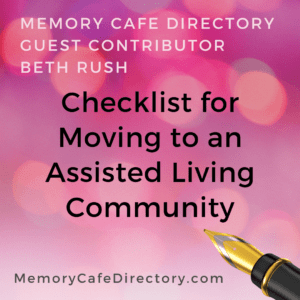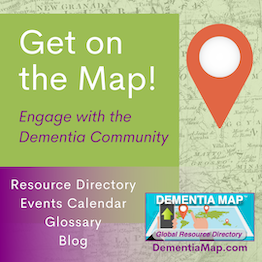Memory Cafe Directory posts and/or links to retailers can be advertising, sponsored, or affiliate links. We may earn a small commission from them. Thank you.
Moving to assisted living can be challenging for the older adult and their family members. Deciding on a new home, finding the right facility, organizing your finances and coordinating the moving process are just a few big hurdles to jump.
You need a step-by-step plan to ensure things go as smoothly as possible. This comprehensive checklist includes everything you need to know about moving to an assisted living facility. Treat this as a “To-do List” to get you started.
1. Start With an Open Dialogue
Moving from one’s current home to assisted living is a complex topic to discuss, but families need to have an honest conversation. Usually, the children have to broach the subject once their aging parents can no longer care for themselves in their family home. As you might expect, older adults are often anxious about transitioning to a retirement community or hospice care facility.
Where does the dialogue begin? How can adult children talk about moving to assisted living with a realistic yet sensitive approach? The Hospice Foundation of America recommends a variety of questions as the best way to break the ice and start the discussion of important topics:
- What do you value most about your life?
- How do you feel about longer hospitalization or time in a nursing home?
- Would you want no pain, even if it meant trading comfort for alertness or wakefulness?
- Who do you want by you when you’re dying?
- If applicable, do you still want to pursue every treatment, realizing some could negatively affect your quality of life?
- Would you want to cease curative efforts if they were unsuccessful?
Answering these questions will help your family develop an appropriate end-of-life care plan and narrow down your assisted living options. However, you must prepare for the conversation to get emotional. Don’t let those emotions distract you from weighing the situation objectively.
2. Understand Your Financial Situation
Once you discuss the idea of moving to assisted living, your family needs to get a clear understanding of its financial situation. Do you have enough money for a facility with full-time caregivers and top-notch amenities? Demonstrating fiscal responsibility is important because it gives elderly parents peace of mind as they transition to assisted living.
These pieces of information will give you a solid grasp of your family’s financial situation:
- Monthly living expenses
- Outstanding debts including credit cards
- Investment portfolios
- Insurance plans
- Retirement savings
If any of these areas show cause for concern, you must address them quickly before moving to the next step. Engaging the services of a financial advisor may be a good idea. It’s critical for family members to get their finances in order so their parents can settle into a new community worry-free. Start by helping them with their debts and committing more income to their retirement savings.
Getting financial assistance from extended relatives or exploring new income options might also be necessary before your parents relocate. It might take several months or years before your family has the financial resources to afford a reputable assisted living facility.
3. Create an End-of-Life Care Plan
Before choosing a facility and moving to assisted living, you must create a comprehensive end-of-life care plan for your aging parents. This conversation will require your family to make many tough decisions over a long period. Plans could change in the future if a new health condition develops or if your financial situation changes.
Start by getting a professional prognosis. Ask the doctor for a realistic estimate of your loved one’s remaining life span. Explore all possible medications, surgeries and therapy methods you could include in the end-of-life care plan. Keep in mind that some treatments might help your parents live longer but reduce their quality of life in the process.
Most patients only require assisted living in a supervised facility, but palliative care might be necessary in the future. Palliative care has shown to improve quality of life by alleviating side effects, discomfort, symptoms, emotional stress and complications from illnesses. If your loved one suffers from a serious chronic medical condition, palliative care should be a part of their end-of-life care plan.
Your loved ones might have to endure many doctor visits to understand what types of care they need. If your aging parents are still mentally sharp, take their input seriously when creating the plan. For example, they might want to skip certain treatments, such as having a caregiver bathe them and prepare meals. Older adults who still have cognitive functions are often willing to sacrifice some comfort to maintain independence.
However, if your loved one is no longer mentally or emotionally present, it’s up to the children and doctors to make all the end-of-life decisions. If you find yourself in this situation, you need to provide a HIPAA release form at each appointment so you can freely discuss your parents’ private medical information.
4. Explore Your Assisted Living Facility Options
Now, it’s finally time to explore your assisted living facility options. The end-of-care plan is the main deciding factor. You need to find a facility that can provide your aging parents with all the necessary treatment and daily assistance. However, you also need to consider many other important factors:
Location
Although a local senior living community is ideal, don’t hesitate to explore options in other towns or states. For example, it’s extremely common for older adults to relocate to warmer states like Florida and Arizona. However, being a long way away may be an issue and easy access may be important.
Amenities
Your loved ones might prefer their new residence to have a fitness center, swimming pool, library and other unique amenities. Regardless of the location, any facility that helps its patients stay physically and socially active is worth a second look.
Independence
Some assisted living facilities have more limitations than others. If your aging parents want to bring a pet or attend social events in the local community, the facility must allow that level of independence. It’s a good idea to explore all the nuances possible, especially surrounding the independent living options.
After narrowing your options to a handful of facilities, the whole family should take an in-person or virtual tour. Observe the interactions between caregivers and patients. Talk with staff members. Inspect the living space, including bedrooms, bathrooms, dining rooms and other essential areas. Ask to see common areas, laundry services, and discuss emergency services. You should also use the tour as an opportunity to explore the surrounding town or city. A real estate agent may be helpful in that regard.
5. Estimate The Facility’s Costs
Once you choose your facility, you must estimate the monthly costs of moving to assisted living. The expenses can vary widely, but knowing the national average is helpful. According to the latest Genworth Cost of Care Survey from 2020, these were the average assisted living costs for American seniors by day, month and year:
- $141/day
- $4,300/month
- $51,600/year
Your family’s expenses depend on the level of care your aging parents require. Assisted living communities will be more affordable if they only need help with daily chores such as preparing meals and cleaning their rooms. If they need round-the-clock assistance, expect to pay above the national average.
6. Capitalize on Financial Assistance Opportunities
The costs of an assisted living facility can be extremely expensive. The good news is older adults have many opportunities to get various forms of government financial assistance.
Your elderly parents might also be eligible for tax write-offs, including the Medical Expense Deduction. If you spend 7.5% of your adjusted gross income or more on the assisted living facility, this policy will automatically lower your annual taxable income. It covers numerous medical expenses, including medications, surgeries, mobility devices and preventative care.
Other common forms of financial assistance include social security disability insurance, supplemental security income and optional state supplements. However, the regulations surrounding these policies can vary by state, so your location might limit your eligibility.
7. Start the Downsizing Process
Now that you’ve covered all the monetary steps of moving to assisted living, you can focus on the physical relocation process. Start downsizing your loved ones’ belongings and determining what they should bring to the facility. It will be an emotional challenge, but you can’t be too sentimental. Instead of dwelling on old memories, focus on the positive changes ahead.
Your loved ones might want to bring a few pieces of furniture to their new address, but most of their belongings will be small personal items. Clothes, books, electronics and family heirlooms will probably make up most of the things they want to bring. That means you need to get rid of lots of big items.
Separate all the things they don’t want to bring into three piles — sell, donate and dump. It will make the packing process significantly easier! Some items like perishable food and kitchen appliances are great donations. You can make a lot of money selling bigger items like old television sets and furniture on online marketplaces. Anything that’s damaged should go in the trash.
8. Locate and Update Essential Legal Documents
Another vital part of moving to assisted living is gathering and updating the patient’s essential documents. This information is for your family, not the facility. Your aging parents need to have their affairs in order for when they pass away. Make sure you get these important papers:
- Birth certificate
- Social security card
- Wills and trusts
- Bank accounts
- Pensions
- Durable power of attorney
You might also have to update their health, life and disability insurance plans. These plans can cover some of the facility’s expenses if you take advantage of the right policies. Talk to your parents’ insurance provider about changing their plans before making the move.
9. Confirm a Moving Date
Once all their belongings and documents are organized, it’s time to confirm a move-in day. Link up with a senior move manager to get the necessary paperwork, moving vehicles, and lifting power. Bringing a professional will also give your loved ones peace of mind and help them feel more secure during this time of transition.
Moving day will inevitably be an emotional experience. That’s why you need to set the date at least a few weeks in advance. Older adults need time to process significant change. It’s crucial that you give them plenty of time to say goodbye to their own home.
You also need to set the moving date weeks in advance for financial reasons. Moving into the facility on the first day of the month will make it easier to track monthly expenses. However, the first day also tends to be the busiest moving day of the month for senior living communities. If you want to avoid the crowds, set the date on a random weekday in the middle of the month.
10. Get Acclimated to the Facility
The first day for new residents in a new environment is always the most difficult — especially for a senior citizen. Your family member might have trouble sleeping on the first night. Their appetite and behavior might temporarily change as well. These are natural reactions every patient typically goes through before getting acclimated to the facility.
To make the acclimation process more manageable, try to make their bedrooms as comfortable and familiar as possible. Organize the furniture the same way it was at their own home, taking into account of course the new floor plan. Use the same sheets and blankets. Put the same pictures on their nightstand. Do whatever they ask — within reason — to make the bedroom feel like home.
11. Get Involved in the New Community
Socialization is crucial for the health of your aging family members. Helping them get involved in different activities with their new community and getting to know some of the current residents is a great first step. Some common activities at senior living communities include card games, Bible studies, and book clubs. These pastimes provide plenty of mental stimulation as well as social interaction.
The best thing you can do is sign your loved ones up for outdoor activities so they get plenty of exercise, sunlight and fresh air. Playing low-intensity sports, gardening or taking routine nature walks are fantastic ways for seniors to stay active with minimal risk of injury.
Always Stay in Touch
Once your relatives get settled into their new environments at the retirement community, you have one simple responsibility — stay in touch. Visit them as often as you can, make regular phone calls and write letters. Moving to assisted living will be a difficult adjustment for them, but it will be much easier with your unwavering love and support.
The most important part about this moving checklist is your commitment to giving your parents quality end-of-life care. While it will be an emotional time for everyone, know you’re doing what’s best for them.
About the Author
Beth Rush

Beth Rush
Beth Rush is the Managing Editor and Content Manager at Body+Mind.
Body+Mind features articles about diet, fitness, mental health, parenting and health care.
Become a Contributor!
 Do you want to be a Memory Cafe Directory contributor? If you have helpful information to share with our community, read about the guidelines, then get in touch to discuss what you have to offer.
Do you want to be a Memory Cafe Directory contributor? If you have helpful information to share with our community, read about the guidelines, then get in touch to discuss what you have to offer.
Thank you.






